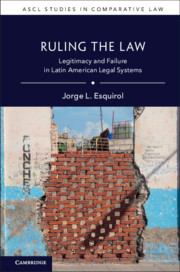Book contents
- Ruling the Law
- Ascl Studies in Comparative Law
- Ruling the Law
- Copyright page
- Dedication
- Contents
- Acknowledgments
- Cited Cases and Arbitral Awards
- Introduction
- 1 The Fiction of Legal Europeanness
- 2 The Fiction of Failed Law
- 3 The Geopolitics of Latin American Legal Fictions
- 4 Latin American Cases
- Concluding Thoughts
- References
- Index
Introduction
Published online by Cambridge University Press: 31 October 2019
- Ruling the Law
- Ascl Studies in Comparative Law
- Ruling the Law
- Copyright page
- Dedication
- Contents
- Acknowledgments
- Cited Cases and Arbitral Awards
- Introduction
- 1 The Fiction of Legal Europeanness
- 2 The Fiction of Failed Law
- 3 The Geopolitics of Latin American Legal Fictions
- 4 Latin American Cases
- Concluding Thoughts
- References
- Index
Summary
Latin American countries have many laws and legal institutions similar to those in continental Europe and the United States. The region’s legal history is closely tied to developments in the West. Beginning in the 1500s, Spain and Portugal ruled the region for approximately 300 years. After national independence in the early nineteenth century, Latin American leaders looked to other European models and the US constitution. The legal rules of private transactions, criminal justice, court procedures, and administrative actions are all patterned on continental European sources. Legal borrowings from these same countries continue to this day. In addition, early national constitutions were heavily indebted to the 1787 US charter. Constitutional reasoning has also increasingly become influenced of late by Anglo-American legal thought. Many Latin American jurists quite purposefully emphasize these connections, and comparative legal scholars around the world have generally confirmed it. Latin American law is part of the European legal tradition, albeit marked by US constitutional influence.
- Type
- Chapter
- Information
- Ruling the LawLegitimacy and Failure in Latin American Legal Systems, pp. 1 - 25Publisher: Cambridge University PressPrint publication year: 2019

